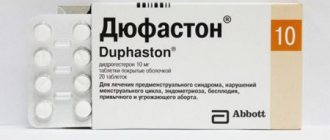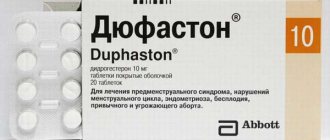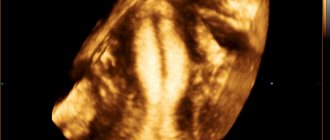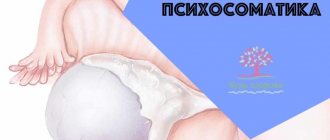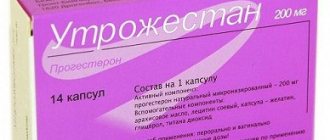Utrozhestan for ovarian cysts: how to take?
An ovarian cyst is one of the most dangerous, and, unfortunately, the most common gynecological diseases, occurring mainly in women of reproductive age.
This is a benign formation located on the tissues of the ovary and has the shape of a bubble filled with liquid, sometimes with bloody impurities. The main danger of ovarian cysts is that this disease can lead to serious problems with conception, and subsequently to infertility. In addition, the so-called “leg” of the cyst can twist, which can lead to severe internal bleeding. Well, perhaps the main danger of this gynecological pathology is that it can change from a benign form to a malignant one. These and many other factors clearly indicate that the treatment of ovarian cysts should be approached with all responsibility and seriousness. Utrozhestan is one of the effective medications used to treat ovarian cysts. What is Utrozhestan and how to use this medicine in the treatment of gynecological diseases?
Utrozhestan temperature
Since the drug resembles endogenous progesterone, Utrozhestan can raise body temperature and also have a sedative effect. With a body temperature reaching 37.0 ⁰С - 37.4 ⁰С, a woman should not worry: the so-called “progesterone” temperature can be an indirect sign of the onset of a long-awaited pregnancy. Utrozhestan and basal temperature, respectively, behave in a similar way - it may be normal or slightly elevated, but the artificial hormone does not directly affect it.
Utrozhestan: pharmacological properties
This is a hormonal drug that contains the hormone progesterone (hormone of the corpus luteum of the ovary, produced in the female body), obtained from raw materials of plant origin. The main feature of the drug is its unique composition, which at the chemical level completely replicates the progesterone molecules. The drug has the same effect on the female body as natural progesterone - it helps maintain the uterine mucosa in the secretory phase, optimally prepares the endometrium for egg implantation, reduces the excitability and tone of the uterus and fallopian tubes, has a pronounced sedative, antiestrogenic, antiandrogenic and antialdosterone effect. effect.
When treating ovarian cysts, Utrozhestan is often included in a complex of therapeutic measures. As you know, to treat this gynecological disease, medications are used that can fully regulate the hormonal levels of the female body. It is for this purpose that Utrozhestan is prescribed - to normalize hormonal balance. The drug has a positive effect on the condition of the ovaries and endometrium, which makes it possible to cure such a complex disease as an ovarian cyst in the shortest possible time.
Utrozhestan is available in the form of suppositories and light yellow capsules coated with a soft gelatin shell. The main active substance is natural micronized progesterone. One capsule contains 100 or 200 mg of progesterone.
Utrozhestan and weight
Some girls are worried when taking Utrozhestan, is it possible to gain weight? Does it make you fat? Indeed, weight gain when taking hormonal medications can be observed, but this is not a direct effect of artificial progesterone, but only a consequence of a general imbalance of hormones in the female body. Weight gain, especially during pregnancy, is normal. Excess weight is removed after the course or after pregnancy is resolved. Whether your weight gain is acceptable or not, decide with your personal doctor on an individual basis.
Recommended dosage
Utrozhestan is a drug with an extremely wide spectrum of action, and therefore the recommended dosage of the drug is determined individually in each specific case.
How to take Utrozhestan when treating ovarian cysts? In most cases, gynecologists advise their patients to take 200 - 400 mg of the drug daily, dividing this dose into two doses. At the initial stage of the disease, it is enough to take 200 mg of the medication; for more advanced forms, the best option would be a dosage of 400 mg.
To cure an ovarian cyst, taking Utrozhestan should be started strictly as prescribed by the doctor, since in this situation the menstrual cycle of each individual woman plays a huge role. In the vast majority of cases, gynecologists advise starting to take the drug from the 16th to 26th day of the cycle - that is, the duration of the course of treatment is 10 days, after which a break is taken and, if necessary, treatment with Utrozhestan continues. This dosage cannot be considered universal - for each woman with an ovarian cyst it is calculated individually.
If it has been decided to use a medication in the form of vaginal suppositories, then the recommended dosage consists of administering 300 - 600 mg of the drug from the 17th to the 27th day of the menstrual cycle.
Reception for other diseases
Utrozhestan is used for various diseases accompanied by hormonal imbalance, in particular low levels of progesterone. Pathologies and dosage regimen:
| Indication | Reception scheme |
| Insufficiency of the second phase of the cycle, menopause | Orally, 1 capsule 100 mg 2-3 times a day, on days 16-25 of the cycle. |
| Low progesterone levels | Orally, 2 capsules of 100 mg on days 16-25 of the cycle, in menopause - 25 days. |
| Progesterone deficiency during pregnancy | Vaginally, 200-400 mg per day until week 20, 100 mg per day until week 32. |
| In Vitro Fertilization | Vaginally, 400-600 mg per day from the first day of the procedure until the 20th week of pregnancy. |
| Prevention of spontaneous abortion | Vaginally, 200-400 mg per day until the 20th week of pregnancy. |
| Infertility | Vaginally, 200-300 mg per day from days 16 to 25 of the cycle. |
Before use, you should consult your doctor. Self-treatment with Utrozhestan is prohibited.
During pregnancy
During pregnancy, a lack of progesterone can lead to miscarriage. Low levels of this hormone increase uterine contractility. In this case, drug support with Utrozhestan is required. Effect of the drug during gestation against the background of an ovarian cyst:
- prevention of tumor growth;
- maintaining the vital activity of the fetus;
- normalization of progesterone levels in the blood;
- preventing spontaneous abortion.
During pregnancy with an ovarian cyst, Utrozhestan is necessary only with a low level of progesterone. Its use is also possible in case of active growth of an ovarian cyst against the background of hormonal imbalance. In other cases, the use of the medication is not advisable.
Treatment during thrush
The action of Utrozhestan does not affect the occurrence of thrush in any way. The main reason for the exacerbation of candidiasis during the treatment of ovarian cysts is insufficient hygiene of the genital organs in the case of vaginal use of capsules. This is due to the large amount of discharge due to suppositories and the need to wear daily sanitary pads, which promotes the development of yeast-like bacteria. Therefore, when treating with Utrozhestan, it is recommended to wash the genitals with clean water 2-3 times a day.
Contraindications for use
Utrozhestan should not be used in the following cases:
- the presence of thrombophlebitis, acute phlebitis, varicose veins;
- incomplete abortion;
- bleeding from the genitals, the cause of which has not been established;
- porphyria;
- the presence of malignant neoplasms in the genitals or mammary glands;
- hypersensitivity to one or more components of the drug;
- the presence of serious liver or kidney dysfunction.
Overdose and side effects
It should be noted that overdose symptoms, as well as side effects of the drug, can only occur if taken orally. No adverse reactions were recorded when using vaginal suppositories. Taking Utrozhestan can cause the following reactions in the body:
- allergic skin reactions - redness, rash, itching, swelling and peeling of the skin;
- headaches, severe dizziness, drowsiness, sudden mood swings;
- slight bleeding from the vagina, which is in no way related to the menstrual cycle (an extremely rare occurrence).
In case of an overdose of the drug, the same symptoms may occur. In this case, experts recommend reducing the dosage of Utrozhestan used or replacing the capsules with vaginal suppositories.
Utrogestan and menstruation (menstruation)
When taking Utrozhestan, your periods may behave in an unusual way. In particular, your period does not come, and this may indicate either pregnancy or a delay (usually it is believed that you can wait up to 5 days). Did your period start early? Sometimes, under the influence of the hormone, there is a shortening of the cycle, as well as slight uterine bleeding between menstruation. When acyclic bleeding occurs, it is better to stop taking it and find out the cause of the bloody discharge as accurately as possible. If progesterone is normal, and this is indicated by the test results, do not self-medicate so as not to upset the hormonal balance in the body.
special instructions
Utrozhestan can be used in all trimesters of pregnancy and during breastfeeding - but only under the strict supervision of the attending physician.
This hormonal drug does not have a contraceptive effect, so it is strictly not recommended for use as a contraceptive.
When using Utrozhestan in the treatment of ovarian cysts, you should remember that this drug may have a certain effect on the ability to concentrate. That is why, throughout the entire course of treatment, you need to be especially careful when driving vehicles or dangerous production mechanisms.
Utrozhestan is a hormonal drug with a broad spectrum of action, but, despite its hormonal nature, the drug does not cause weight gain.
Alcohol has no effect on the action of the drug, but you must remember that alcohol-containing drinks can significantly worsen the general condition of a woman with an ovarian cyst. It is advisable to stop drinking alcohol for the entire course of treatment.
Contraceptive drugs
This category of drugs is important in the treatment of cysts. They restore hormonal balance and promote spontaneous resorption of formations. The most effective drugs include:
- Regulon for ovarian cysts suppresses ovulation and the production of gonadotropins by the pituitary gland. However, it must be taken into account that this drug has many contraindications, so it should be used with extreme caution and only under the supervision of a doctor.
- Janine. It is prescribed to give the ovaries a chance to rest. These tablets are most effective for endometrioid cysts. In addition to normalizing ovarian function, Janine also helps improve hormonal balance.
- Buserelina. When using an injection solution or spray, the synthesis of sex hormones is suppressed. This leads to the fact that the ovaries are temporarily put into a state of artificial menopause. Also, under the influence of Buserelin, the growth of cystic formations stops.
For endometriosis
This is a pathology in which the epithelium lining the inner surface of the uterus begins to grow in other parts of the woman’s reproductive system.
Like normal endometrium, the development of this tissue depends on the phase of the menstrual cycle. Therefore, this disease is characterized by cyclical occurrence of pain and bleeding.
The treatment of endometriosis is based on the use of hormonal drugs based on progesterone or its analogues. The most common representatives of this group of medications are Duphaston and Utrozhestan.
They are administered orally in tablet form. It is prohibited to start treatment on your own due to the risk of side effects. The dosage is selected by the attending physician based on the patient’s examination data.
Duphaston should be used twice a day, one tablet containing 10 mg of the active substance. It is important that the medication is taken at the same time - this way the concentration of the hormone in the blood will correspond to natural daily fluctuations. It should also be taken only during the period from 5 to 25 days of the menstrual cycle.
The duration of the main therapy is approximately three weeks. If necessary, the doctor can extend treatment up to nine months. The dosage should be reduced every week, since sudden withdrawal can lead to exacerbation.
Features of application
Before starting treatment for endometrioid and other ovarian cysts with Utrozhestan, it is necessary to take into account all the features of its use. Additional characteristics of the drug:
- allowed during pregnancy, but only with the prescription of a gynecologist;
- has little effect on concentration and ability to drive;
- does not have a contraceptive effect;
- does not cause weight gain;
- treatment with Utrozhestan is often accompanied by drowsiness.
When administered orally, the drug enhances the effect of diuretics, immunosuppressants, anticoagulants, and medications to lower blood pressure. The effect of Utrozhestan decreases when taking antibiotics, alcohol, or smoking.
For uterine fibroids
They call it a benign neoplasm growing from the muscular part of this organ.
This disease often occurs in women over 40 years of age, but it can also appear at a younger age. It leads to difficulty in bearing a child and can put pressure on the pelvic organs and disrupt their function.
The treatment of fibroids, like any other neoplasm, is based on surgical methods. However, combination therapy is currently considered more effective. It is carried out in two stages:
- the use of hormonal drugs to reduce tumor size;
- surgical removal of the tumor.
With an ovarian cyst
A cyst is a tumor-like neoplasm in the ovary, which has a cavity inside and is filled with fluid. There are types of cysts, the growth and development of which depends on the hormonal background of the woman:
Since the mechanism of development of these pathologies is different, treatment with progesterone in each case also has its own characteristics.
A follicular cyst occurs at the site of an undeveloped egg. Usually it resolves on its own, but if this does not happen, the use of progesterone drugs is necessary.
It is recommended to take Utrozhestan 200 or 400 mg from the 17th to the 26th day of the menstrual cycle. This leads to an increase in the level of gestagens in the woman’s blood, which will cause the cyst to resolve.
A luteal cyst is formed from an unresolved corpus luteum. Progesterone is used in the early stages of the disease in the same dosages.
Endometrioid cysts are cavities in the ovary filled with endometrial cells. Drug treatment in this case does not differ from the treatment of endometriosis.
Treatment of corpus luteum cyst with Duphaston
The most common type of cyst is the corpus luteum cyst. Its formation and development in most cases is asymptomatic, but when it reaches a large size, it makes itself felt: sharp pain may appear in the second half of the menstrual cycle, and torsion of the cyst leg also occurs, accompanied by severe pain. It can lead to inflammation and necrosis of part of the ovary. Such problems can only be solved surgically.
But as long as the growth of the corpus luteum cyst does not lead to similar consequences, it can be completely cured by taking hormonal contraceptive oral medications. Doctors often recommend taking Duphaston. Its effect on the cyst is quite simple: being an analogue of progesterone, it compensates for the lack of this hormone in the woman’s body, which leads to a decrease in the production of luteinizing hormone by the pituitary gland, which, in turn, leads to inhibition of the cyst cells and its complete destruction.
Contraindications
The drugs are contraindicated for use in women with hypersensitivity to the active substance. The medicine in capsule form cannot be used for liver diseases accompanied by impaired liver function.
The exchange of exogenous progesterone, that is, obtained from medications, occurs in the liver. Therefore, taking such drugs significantly increases the load on this organ.
They are also contraindicated in the presence of diseases associated with increased blood clotting. In such patients, the risk of developing thromboembolism of large arteries increases sharply.
You should also not use hormonal drugs with acute phlebitis, vaginal bleeding without an established cause, porphyria and incomplete abortion.
Use with caution when:
- arterial hypertension and other diseases of the cardiovascular system;
- bronchial asthma;
- diabetes mellitus;
- impaired kidney function;
- pathologies of the central nervous system, for example, epilepsy, depression, migraine.
In addition, it is limited for use in the second and third trimesters of pregnancy, as well as during breastfeeding.
Side effects and contraindications
The difference between Duphaston and natural progesterone, as well as other gestagens, is that dydrogesterone has an improved formula, thanks to which the drug has virtually no side effects during the treatment process. There are also few contraindications for use in therapy, thanks to which Duphaston is one of the most prescribed progestin agents in the treatment of progesterone deficiency.
Contraindications for use
Duphaston is contraindicated in the following cases:
- intolerance to the active and excipients of the drug;
- use with caution if skin itching was detected during a previous pregnancy;
- severe liver diseases.
During pregnancy, the drug is indicated for use if there are corresponding symptoms for taking Duphaston.
During lactation, the use of this medicine is undesirable due to the passage of dydrogesterone into breast milk.
Side effects from taking
Duphaston does not have unwanted androgenic side effects, since it is not synthesized from testosterone, like most synthetic progesterone substitutes, but is close in composition to natural progesterone. Thanks to this, when taking the drug, there is no change in the timbre of the voice, the appearance of acne or increased hair growth on the body.
Table: side effects from therapy
| Body system affected by the side effect | Side effect | Frequency of occurrence |
| Hematopoietic system | hemolytic anemia | isolated cases |
| The immune system | hypersensitivity reactions | very rare cases |
| central nervous system | migraine and headache | in rare cases |
| Hepatobiliary system | liver dysfunction | |
| Reproductive system | breakthrough uterine bleeding, increased sensitivity of the mammary glands | |
| Excretory system from the skin | allergic reactions (hives, itching, rash) | |
| Quincke's edema | very rarely |
If breakthrough uterine bleeding occurs, the dose of the drug should be increased. Usually this side effect is typical for the first months of taking Duphaston.
How to cure an ovarian cyst without surgery
The formation of cysts is often observed in women of reproductive age. Neoplasms are usually a diagnostic finding because they tend to progress asymptomatically. When it reaches a large size, pain localized in the lower abdomen and disruption of the functioning of neighboring organs may appear. In advanced cases, surgery may be required.
Gynecologists call hormonal imbalances the main cause of formations. The classification includes the following types of cysts:
- single and multiple;
- one-sided and two-sided;
- uncomplicated and complicated;
- follicular, corpus luteum, paraovarian, dermoid, endometrioid.
In rare cases, the cyst may be complicated by torsion of the pedicle, rupture of the capsule and suppuration, which requires surgery.
https://youtu.be/SAXwaG9HQjU
Treatment of ovarian cysts can be either conservative or surgical. Drug therapy involves taking medications prescribed by a doctor. Treatment is complemented by physiotherapy. Traditional remedies have a good effect. If drug treatment is not effective, surgery is recommended.
Instructions for use of Duphaston
The drug is recommended for use in accordance with the attached leaflet.
Examination and tests before prescribing Duphaston
The patient undergoes a full diagnostic examination:
- examination by a gynecologist - to determine pathological changes or abnormal bleeding,
- mammography – shows the general condition of the breast,
- hormonal analysis.
Admission rules
Duphaston is intended for oral administration, 1-2 units per day, depending on the subtype of the disease. Reception does not depend on food, application is carried out at regular intervals. The patient is required to strictly follow the cyst treatment algorithm prescribed by the doctor.
Treatment during pregnancy
Duphaston helps reduce the threat of miscarriage that occurs due to progesterone deficiency.
Features of therapy during lactation
The active ingredients of the product easily pass into mother's milk, which is a contraindication for use. If Duphaston therapy is necessary, stop breastfeeding.
Taking the drug in childhood
The formation of cysts is also registered in adolescence, which allows Duphaston to be prescribed by a pediatric gynecologist. The therapy avoids surgery.
https://youtu.be/BORVFN8GUuI
Physiotherapeutic methods
Treatment of the appendages includes the use of surgery, medications and physical therapy. As a rule, physiotherapeutic agents are used for long-term progressive, recurrent formations. Physiotherapy for ovarian cysts has a resolving and anti-inflammatory effect, helping to restore adequate blood circulation.
Balneotherapy
The procedure involves irrigation of the vagina using various medications. The balneotherapy method also involves the use of medicinal baths.
Magnetotherapy
The technique is indicated for benign tumors of the internal genital organs. Magnets produce an anti-inflammatory effect, which helps reduce pain.
Ultraphonophoresis
During a physiotherapeutic session, a specialist applies a medication to the skin in the projection of the affected organ for the purpose of ultrasound irradiation.
Medications
The method of treating pathology does not only involve surgical removal of tumors. In some cases, it is possible to treat cysts without surgery, that is, with medication.
Gynecologists prescribe pills for ovarian cysts:
- Regulon. The drug belongs to the COC group. Regulon for ovarian cysts is prescribed from the first day of the cycle. The drug is highly effective for hormonal disorders accompanied by polycystic disease. Regulon is recommended for use for a duration of 3 months. The medicine reduces the production of gonadotropins by the pituitary gland of the brain, which leads to normalization of the cycle. When using the drug Regulon for ovarian cysts, reviews from women are mostly positive.
- Norkolut. The drug is recommended for the treatment of a functional type of formation. Norkolut for ovarian cysts eliminates concomitant cycle disorders and manifestations of endometriosis.
- Yarina. This is a low-dose COC containing estrogen and progestogen. Yarina for ovarian cysts is used as a contraceptive with a therapeutic effect. The drug eliminates pain in the lower abdomen, bleeding, and prevents the risk of anemia.
- Janine. The oral contraceptive blocks the production of FSH, which leads to a lack of ovulation. Janine for ovarian cysts is used to normalize menstrual function.
- Jess. The drug contains drospirenone and is considered one of the most effective COCs.
- Marvelon. The hormonal agent includes desogestrel. Marvelon can be prescribed for follicular neoplasms.
- Rigevidon. The main active ingredients are tinyl estradiol, levonorgestrel.
- Utrozhestan. This is a natural analogue of the hormone progesterone. Utrozhestan for ovarian cysts is taken in a dosage of 200-400 mg (twice a day).
- Duphaston. The drug is a synthetic analogue of progesterone produced by the corpus luteum.
- Cyclodinone. Cyclodinone tablets for ovarian cysts normalize prolactin levels in the body. The herbal medicine is used for 3 months.
- Wobenzym. The medicine has an anti-inflammatory, immunostimulating effect. Wobenzym has a wide range of indications and is often prescribed for tumors of benign etiology, after operations.
Suppositories for ovarian cysts in women include:
- Longidazu. The drug has a resolving effect and is used to eliminate cystic formations and adhesions accompanying the inflammatory process. Suppositories can be used after surgery.
- Ichthyol suppositories. The medicine has antiseptic and analgesic properties and helps normalize blood circulation.
- Terzhinan. The medication is used as part of a complex treatment.
- Diclofenac. Rectal suppositories reduce pain and inflammation, including after surgery.
- Indomethacin. The drug is used in the treatment of inflammatory processes.
General concept of ovarian cystic formations
The indication for the use of Duphaston is an ovarian cyst. There are several types:
- A follicular ovarian cyst occurs due to the fact that ovulation does not occur, that is, the rupture of a mature follicle does not release the egg.
- An ovarian corpus luteum cyst is formed due to a stop in the progression of this formation. It is asymptomatic for a long time and does not require treatment.
- Ovarian dermoid cysts develop during embryogenesis. In its cavity you can find hair, teeth, eyes, nails and the rudiments of internal organs. She cannot be treated with Duphaston.
- A mucinous cyst of the right or left ovary is a multi-chamber formation whose cavities contain mucus. When it is perforated or ruptured, the pelvic cavity and peritoneum are seeded with specific cells that are suspended in mucin.
- With genital endometriosis, an endometriotic cyst is formed. Its symptoms become more pronounced during menstruation. Duphaston is recommended for the treatment of endometriosis.
Almost all functional ovarian cysts are asymptomatic if their diameter does not exceed three centimeters. When they reach large sizes, they compress the adjacent ovarian tissues, cause oppression of the follicles and replacement of the structures of the uterine appendages with connective tissue elements.
If you have ovarian cysts, the following complications are possible:
- leg torsion;
- perforation of the cyst wall;
- suppuration;
- rupture of the cyst wall.
They all show similar symptoms:
- nausea or vomiting, which in most cases does not bring relief;
- increasing temperature to 390C;
- acute, sudden pain in the lower abdomen;
- tachycardia;
- tension of the anterior abdominal wall.



